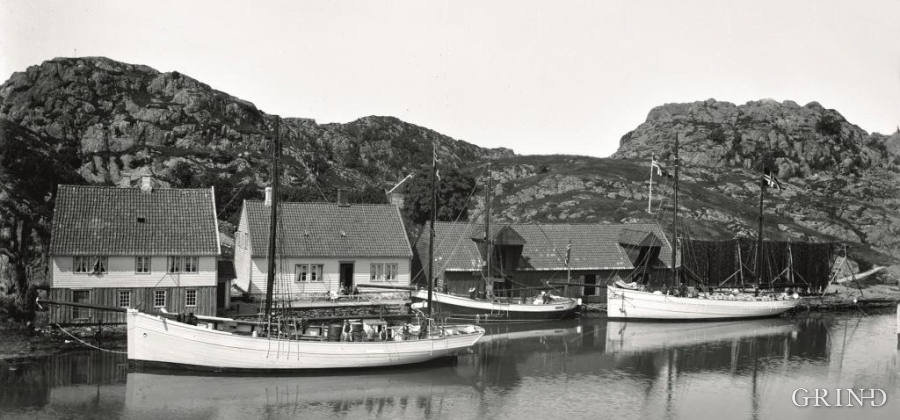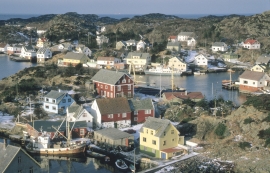Published: 14.01.2013 | Author: Nils Georg Brekke, Kari Shetelig Hovland
Espevær around 1915, at “Biekronå”. Here was the oldest trading post. (Sev. Kannelønning).
In the sea west of Bømlo lies Espevær, half an hour’s rowing trip across the sound from Vespestadvågen. This is a well-run and well-maintained local community, established on the back of the rich herring fisheries in the 1850s. It is fishermen, skippers and the tradesmen who have made their mark on the culture in Espevær, with their contacts to the south towards Haugesund and across the North Sea to the British Isles.
In 1725 Jon Torkelsen obtained a Letter of Royal Privilege to carry on trade and guesthouse business in Espevær. When the spring herring fisheries were over for the season, the Dutch came to the harbour in Espevær to load up with live lobster. In 1849 Hans Jacob Baade from Stavanger bought Kjeholmane (islets). He filled out between the islets to create one large islet; Baadeholmen. He erected salting sheds and built a new large warehouse on the foundations of the old stone boathouse from the 1690s. Baadehuset became an administrative centre during the rich herring fisheries in the middle of the 1800s. A telegraph station was established here already in 1857, as Espevær was very centrally situated in the spring herring fisheries. In Baadehuset there were the doctor’s office, manager’s office and the judge’s office one after the other, and in the loft there was accommodation for fishermen who slept like “sardines in a tin” during the great herring periods. Today Baadehuset is well restored by the local Housewife Association and is open to visitors.
“The southern fishery”
The lucrative spring herring fisheries in the middle of the 1700s on “Sørafeltet” (the southern fishing ground) was a source of great prosperity.
In 1753 a prohibition to transport fresh herring further than 6 miles (60 km) from the fishing area came into force. All herring had to be salted at the place where it was caught, and large salting sheds sprang up in nearly every creek. The spring herring disappeared around 1780, but it returned during the time of poverty 1808-1810. Every year up to 1870 the herring headed towards land in great shoals, at times like a large rock in the sea. Espevær and the Bømla area were in the middle of the route for the spawning herring. For a couple of months after Christmas a fishing fleet of several thousand men from the whole of West Norway gathered, many of which were lodged at Espevær.
Enormous amounts of fish were salted and the fishermen delivered their catch directly to the salting sheds. In Espevær 30 large salting sheds were erected, and 30 in the bays at southern Bømlo, in the years between 1820 and 1860; most of them belonging to merchants from Bergen and Stavanger. There could be between 20-30 gutting girls in every salting shed, as well as workers and coopers who made herring barrels in large quantities.
- Hovland K.S. (1967) Fiske på Bømlo i gamle dagar. I: Sunnhordland Årbok. Stord, Sunnhordland museum, s. 37-53.
- Hovland K.S. (1984) Gamle naust og sjøhus på Bømlo. I: Sunnhordland Årbok. Stord, Sunnhordland museum, s. 77-86.
- Hovland K.S. (1988) Eit skifte i Espevær 1779-81. I: Sunnhordland Årbok. Stord, Sunnhordland museum, s. 113-134.





